Heteroxeny
Heteroxeny, or heteroxenous development, characterizes a parasite whose development involves several host species.[1]

A dixenous life cycle: the apicomplexan parasitic protist Babesia microti and its two different taxonomic hosts, the deer tick and the white-footed mouse.
When there are two or three hosts, the development cycle is named diheteroxenous or triheteroxenous, respectively. More ambiguously, these terms are sometimes synonymized as dixenous or trixenous.[1]
The etymology of the terms heteroxeny / heteroxenous derives from the two ancient Greek words ἕτερος (héteros), meaning "other, another, different", and ξένος (xénos), meaning "foreign".[2][3]
References
- Odening, Klaus (1976-01-20). "Conception and terminology of hosts in parasitology". In Dawes, Ben (ed.). Advances in Parasitology. 14. Academic Press. pp. 24–25. ISBN 978-0-08-058060-9.
- Bailly, Anatole (1981-01-01). Abrégé du dictionnaire grec français. Paris: Hachette. ISBN 978-2010035289. OCLC 461974285.
- Bailly, Anatole. "Greek-french dictionary online". www.tabularium.be. Retrieved May 2, 2020.
This article is issued from Wikipedia. The text is licensed under Creative Commons - Attribution - Sharealike. Additional terms may apply for the media files.